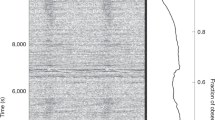Abstract
The 1.5-ms pulsar PSR1937+214 is an unusual object; its extremely short period and slow spin-down rate imply a magnetic field1 of 4×108 G, much lower than that of a canonical pulsar. Contrary to previous models, we propose here, as an explanation for these properties, that PSR1937+214 is a young neutron star (consistent with a kinematic age of ∼106 yr) spun up by accretion from a high-mass companion in a close binary system. The supercritical mass transfer rates expected in such a binary system should allow the neutron star to be spun up in the comparatively short time of ∼104 yr. The accretion process will also power thermomagnetic effects that could remove the strong magnetic field of a young pulsar from the crust of the star in a similarly short timescale. Such a high-mass binary system is expected to disrupt when the companion explodes in a supernova. Thus a spin-up model in a high-mass system can explain the lack of a companion, low magnetic field, and high spin rate of PSR1937+214.
This is a preview of subscription content, access via your institution
Access options
Subscribe to this journal
Receive 51 print issues and online access
$199.00 per year
only $3.90 per issue
Buy this article
- Purchase on Springer Link
- Instant access to full article PDF
Prices may be subject to local taxes which are calculated during checkout
Similar content being viewed by others
References
Backer, D. C., Kulkarni, S. R. & Taylor, J. H. Nature 301, 314–315 (1983).
Backer, D. C., Kulkarni, S. R., Heiles, C., Davis, M. M. & Gross, W. M. Nature 300, 615–618 (1982).
Boriakoff, V., Buccheri, R. & Fauci, F. Nature 304, 417–419 (1983).
Segelstein, D. J., Taylor, J. H., Rawley, I. A. & Stinebrin, D. R. IAU Circ. No. 4162 (1986).
Stokes, G. H., Taylor, J. H., Weisberg, J. M. & Dewey, R. J. Nature 317, 787–788 (1985).
Clifton, T. R. & Lyne, A. G. Nature 320, 43–45 (1986).
Manchester, R. N. & Taylor, J. H. in Pulsars (Freeman, San Francisco, 1977).
Ostriker, J. P. & Gunn, J. E. Astrophys. J. 157, 1395–1417 (1969).
Alpar, M. A., Cheng, A. F., Rudermann, M. A. & Shaham, J. Nature 300, 728–730 (1982).
Rudermann, M. A. & Shaham, J. Astrophys. J. 289, 244–246 (1985).
Jeffrey, L. C. Nature 319, 384–386 (1986).
van den Heuvel, E. P. J. & Bonsema, P. F. J. Astr. Astrophys. 139, L16–L18 (1984).
Brecher, K. & Chanmugan, G. Nature 302, 124–125 (1983).
Arons, J. Nature 302, 301–305 (1983).
Blandford, R. D., Applegate, J. H. & Hernquist, L. Mon. Not. R. astr. Soc. 204, 1025 (1983).
van den Heuvel, E. P. J. & DeLoore, C. Astr. Astrophys. 25, 387–395 (1973).
Begelman, M. C. & Rees, M. J. Mon. Not. R. astr. Soc. 206, 209 (1984).
Königl, A. Mon. Not. R. astr. Soc. 205, 471–485 (1983).
van den Heuvel, E. P. J. Vistas Astr. 25, 95–108 (1981).
Ayasli, S. & Joss, P. C. Astrophys. J. 256, 637–665 (1982).
Fujimoto, M. Y., Hanawa, T., Iben, I. & Richardson, M. B. Astrophys. J. 278, 813–824 (1984).
Hernquist, L. & Applegate, J. H. Astrophys. J. 287, 244–254 (1984).
Urpin, V. A. & Yakovlev, D. G. Soviet Astr. 24, 425–431 (1980).
van den Heuvel, E. P. J. in Accretion-Driven Stellar X-ray Sources (eds Lewin, W. H. G. & van den Heuvel, E. P. J.) 303–341 (Cambridge University Press, 1984).
Taam, R. E., Bodenheimer, P. & Ostriker, J. P. Astrophys. J. 222, 269–280 (1978).
van den Heuvel, E. P. J., van Paradijs, J. A. & Taam, R. E. Nature 322, 153–155 (1986).
Kulkarni, S. R. Astrophys. J. 306, L85–L89 (1986).
van den Heuvel, E. P. J. & Taam, R. E. Nature 309, 235–237 (1984).
van der Linden, T. J. IAU Symp. No. 88, 109–120 (1980).
deKool, M., van den Jeuvel, E. P. J. & Rappaport, S. A. Astr. Astrophys. (in the press).
Author information
Authors and Affiliations
Rights and permissions
About this article
Cite this article
Blondin, J., Freese, K. Is the 1.5-ms pulsar a young neutron star?. Nature 323, 786–788 (1986). https://doi.org/10.1038/323786a0
Received:
Accepted:
Issue Date:
DOI: https://doi.org/10.1038/323786a0
This article is cited by
-
Revisiting Field Burial by Accretion onto Neutron Stars
Journal of Astrophysics and Astronomy (2017)
-
Are the magnetic fields of millisecond pulsars ∼108 G?
Astrophysics and Space Science (2010)
-
Discovery of hard X-ray pulsations from the transient source GRO J1744 – 28
Nature (1996)
-
The evolution of the magnetic fields of neutron stars
Journal of Astrophysics and Astronomy (1995)
-
Genesis of a pulsar's planets
Nature (1992)
Comments
By submitting a comment you agree to abide by our Terms and Community Guidelines. If you find something abusive or that does not comply with our terms or guidelines please flag it as inappropriate.



